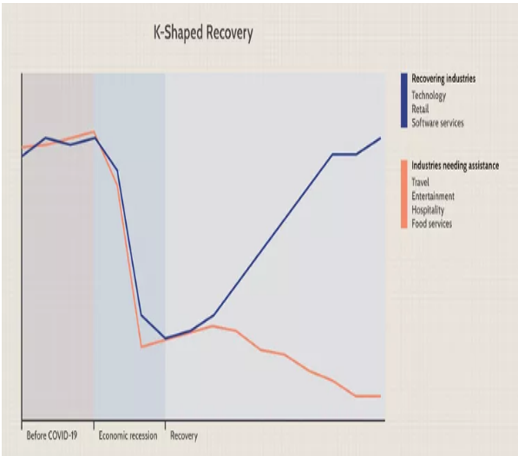Current Context
According to the report released by the Economic Research Department of the State Bank of India (SBI), income inequality has declined in India with a higher tax base and a shift in taxpayers from lower income to higher income tax bracket.
About
- Terming the claims of K-shaped recovery as “prejudiced” and “ill-concocted”, the report also cited the transition of small firms into larger firms and consumption trends being indicative of “vanishing inequality”
Key highlights of the SBI Report:
- Between the assessment years 2013–14 and 2021–22, about 36.3% of taxpayers have moved from lower income to higher income tax bracket resulting in 21.3% additional income.
- The income-tax returns (ITRs) filed by individual taxpayers earning between Rs 5 – 10 lakh, climbed by 295%, showing a positive trend of migration to a higher range of gross total income.
- The number of ITRs filed by people earning between Rs 10 – 25 lakh increased by 291% while the total number of persons filing income tax increased to 7.4 crore in AY23 from 7 crore in AY22.
- Female tax filers are around 15%of the individual tax filers with certain states such as Kerala, Tamil Nadu, Punjab and West Bengal having higher share of female tax filers.
- On the share of top taxpayers in income, the report said that in FY14, the combined income of 23 individuals with income of more than Rs 100 crore was 1.64% of the total income of FY14.
- Even though the number of such individuals increased to 136 in FY21, the share of their combined income fell to 0.77%.
- Also, 19.5% of small firms have transitioned into larger firms through MSME value chain integration and consumption of the bottom 90% of the population has increased by Rs 8.2 lakh crore post pandemic.
- It also cited consumption numbers from food ordering platforms such as Zomato, calling it as the perfect example of case study to refute the claim that people are facing distress.
- The report also talks about the decline in sales of two-wheelers, and people are substituting two-wheelers with four-wheelers.
Conclusion of SBI Report:
- Growth is seen in all income classes but its skewness has been decreasing with convergence of income towards the middle from both top as well as bottom.
- The report said the claim of K-shaped recovery seems flawed, prejudiced, ill-concocted and fanning interests of select quarters to whom India’s remarkable ascendance is quite unpalatable.
- Income inequality captured through the Gini coefficient (one of the most widely used measures of income inequality) of taxable income has declined significantly from 0.472 to 0.402 during FY14-FY22.
K-shaped Recovery
K-shaped recovery occurs when, following a recession, different parts of the economy recover at different rates, times, or magnitudes.
- Because the path of different parts of the economy when charted together may diverge, resembling the two arms of the Roman letter “K”, this type of recovery is called K-shaped.
A K-shaped recovery leads to changes in the structure of the economy or the broader society as economic outcomes and relations are fundamentally changed before and after the recession.

Causes of a K-shaped recovery:
- A K-shaped recovery can reflect creative destruction in an economy, which occurs when new technologies and industries replace older ones over the course of a recession.
- It can reflect the public policy response to a recession in terms of monetary and fiscal policy, which can benefit some segments of the economy more than others – leading to income inequality.
- It can simply reflect the differential impact that the initial recession had on different parts of the economy.
How is it different from other letter-shapes?
- Unlike other letter-shaped descriptors of economic recessions and recoveries (L-shaped, V-shaped, U-shaped, or W-shaped), which describe the path of economywide macroeconomic aggregate variables like gross domestic product (GDP) or total employment.
- A K-shaped recovery describes the path of different disaggregated economic variables, such as income across different segments of society or employment in different industries, relative to one another.

